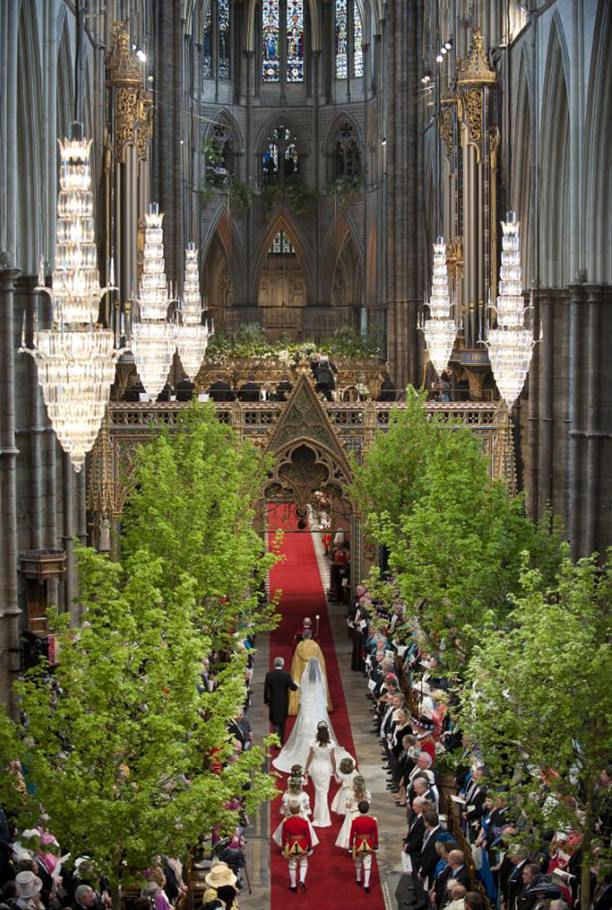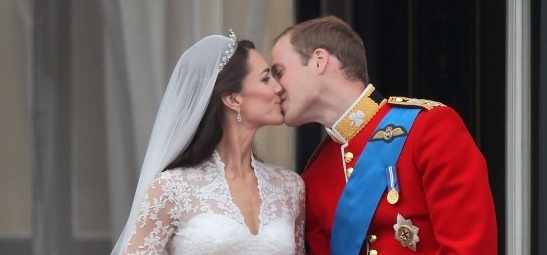In The English Constitution (1867), Walter Bagehot, who understood the irrational, atavistic mystique of the British monarchy better than any commentator before or since, wrote that a royal wedding is “the brilliant edition of a universal fact.” Thus the marriage ceremonial of Prince William of Wales and Catherine Middleton at Westminster Abbey on April 29 captured the attention of hundreds of millions of adepts of electronic media worldwide, who followed the proceedings to a lesser degree than expected on television but availed themselves of live streaming, Twitter, and other social networking sites to an unprecedented extent.
Emblematic of that shift in viewing habits was the wedding’s instant Web star, the so-called Frowning Flower Girl. Following the church service, a three-year-old attendant stole the royal show on the Buckingham Palace balcony during the happy couple’s long-awaited kiss (British royal couples do not do so at the altar), when the poor child grumpily clamped her hands over her ears as RAF planes made a deafening flyby. Global sharing of that hilariously contrarian image—the antithesis of the cherubs at the feet of Raphael’s Sistine Madonna—nearly caused Twitter to crash.
Many among that colossal virtual audience saw this panoply as the proverbial fairytale romance come to life, a Cinderella transformation made all the more magical by the bride’s middle-class origins. Others regarded the foofaraw as an apotheosis of anachronism, with the British royal family, even its youngest and most attractive members, as inexplicable relics of medieval feudalism fetishistically preserved at the very heart of a multicultural post-industrial democracy.
Nonetheless, the British Crown possesses an undeniable genius for staging rituals that may seem to date from time immemorial but which for the most part were concocted in the early twentieth century. They were designed to bestow a numinous aura of legitimacy on an institution shaken by the cataclysm of the Great War, when four other major European monarchies were abolished. That threat prompted England’s ethnically German ruling house to expeditiously change its name from Saxe-Coburg-Gotha to Windsor and mask its Teutonic ties, a penchant for adaptive coloration apparently lost on the present royal family.
Tellingly, the choice of Westminster Abbey as the site of the recent wedding is generally believed to be part of a continuous tradition dating back as far as the nuptials of Henry I in 1100, which were solemnized in a precursor of the present sanctuary. In fact, not since the Plantagenets had the Abbey seen a royal wedding until it was pressed back into service for that purpose soon after World War I.
During that five-century interim, members of the regnant dynasty took their vows in private chapels far from the prying eyes of commoners. However, in order to foster popular loyalty after a dodgy wartime patch, George V—first cousin of England’s archenemy, Kaiser Wilhelm II—turned these once-personal occurrences into patriotic public jamborees.
Royal weddings once called for extravagant street decorations—triumphal arches, miles of bunting, and thousands of banners with cypher initials intertwined. This time around, official trimmings were kept to a bare minimum in order to impart an air of restraint in keeping with the government’s stringent new austerity measures, the full brunt of which was first being felt this April, at the start of Britain’s fiscal year.
Surely the most profligate and pointless embellishments were eight 20-foot-high live maple trees that were hauled into the Abbey nave, root balls and all, to give it the look of a vernal grove, a Green fantasy that betrayed the eco-conscious influence of the groom’s father, Prince Charles. The resultant effect was rather more like an artificially landscaped corporate atrium than a sylvan glade, neither of which had any place in this sufficiently noble landmark of Gothic architecture.
The most eagerly awaited and closely watched design element of the wedding was the bride’s dress, a quite conventional if expertly rendered ensemble by Sarah Burton, who took over as creative director of the London fashion house Alexander McQueen a year ago, after the suicide of its eponymous founder in February, 2010. The current vogue for strapless wedding dresses may well be reversed by Middleton’s appropriately covered-up finery.
This would be all to the good, for there is something weirdly contradictory about innocence-signifying virginal white and a veil being mixed with bare shoulders and deep cleavage more suited to a sexy nightclub chanteuse. Apart from the impeccable turnout of the entire Middleton family— obsessively scrutinized for telltale signs of middle-classness—fashions worn by the wedding guests, royal and otherwise, ranged from tea-cozy frumpish to space-alien freakish, and caused endless merriment on the Internet.
According to a recent Dutch study, the British monarchy is by far Europe’s most expensive. It costs taxpayers some $67 million annually, close to half of which merely goes to the upkeep of the various royal palaces, as opposed to the $12 million a year that funds Spain’s Borbón dynasty, Europe’s cheapest. The Wills-and-Kate festivities alone will set the exchequer back an estimated $45 million, the lion’s share going to security to prevent a recurrence of the violence that engulfed Charles and Camilla—she dripping with huge emeralds in a real Marie-Antoinette moment—in London last December after government cuts for education were announced.
Advertisement
In that respect, the royal wedding day’s most heart-rending moment—given the thoroughgoing social disaster that is about to descend on Britain because of those impending budget slashes—came with the Abbey congregation’s joining in the hymn “Jerusalem,” based on William Blake’s Preface to his Milton: A Poem (1804-1810) and set to music by Hubert Parry (1916). Often called the country’s alternative national anthem, this rousing evocation of England as an earthly paradise ends with a pledge:
I will not cease from Mental Fight,
Nor shall my Sword sleep in my hand:
Till we have built Jerusalem,
In England’s green & pleasant Land
Among those lustily mouthing Blake’s words was Prime Minister David Cameron, whose Conservative-Liberal Democrat coalition has imposed the most severe retrenchment of Britain’s social spending since World War II, including a 300-percent increase in university tuition that, if it is implemented, will wreck the educational prospects of an entire generation. The withdrawal of government support for education—the humanities and arts in particular—has been well underway since the Thatcher regime, a development hardly reversed under Tony Blair. (Neither Blair nor his Labour successor, Gordon Brown, were invited to the wedding, though former Tory premiers Margaret Thatcher and John Major were, under the guise that they are Knights of the Garter.)
A new brain drain recapitulating the exodus of professionals that plagued postwar Britain is well underway and threatens to become even greater, as documented in a scathing and chillingly detailed essay by Claire Bishop, an associate professor of art history at the CUNY Graduate Center who emigrated from the UK to the US in 2008. “The rhetoric of an ‘age of austerity,’” Bishop writes, “is being used as a cloak for the privatization of all public services and a reinstatement of class privilege; a sad retreat from the most civilized Keynesian initiatives of the post-war period, in which education, healthcare, and culture were understood to be a democratic right freely available to all.”
How long the British electorate will subsidize such costly regal pageantry at the expense of day care centers, college degrees, community libraries, and other life-enhancing services remains to be seen. In the fizzy run-up to the big day, a poll indicated that 49 percent of the British public would watch the royal wedding, 62 percent think their country would be worse off without the monarchy, and 46 percent would prefer William to become their next sovereign rather than his father.
In light of the heartless abandonment of utopian principles shared by Blake, Keynes, Atlee, and other British champions of the common man, it is hard to imagine how misappropriated flummery running tens of millions per annum could possibly be justified beyond the lifetime of the Throne’s aged incumbent. But as the nation that reelected George W. Bush has definitively proved, voting against one’s own best interests seemingly knows no bounds, or boundaries.





